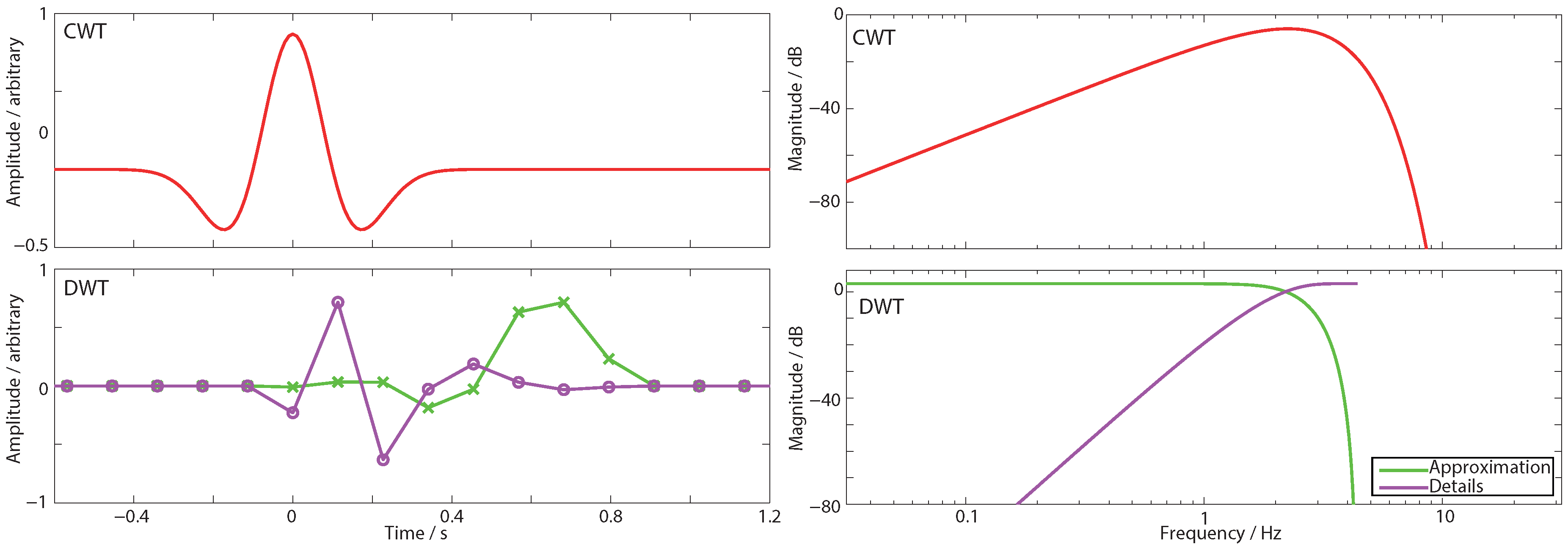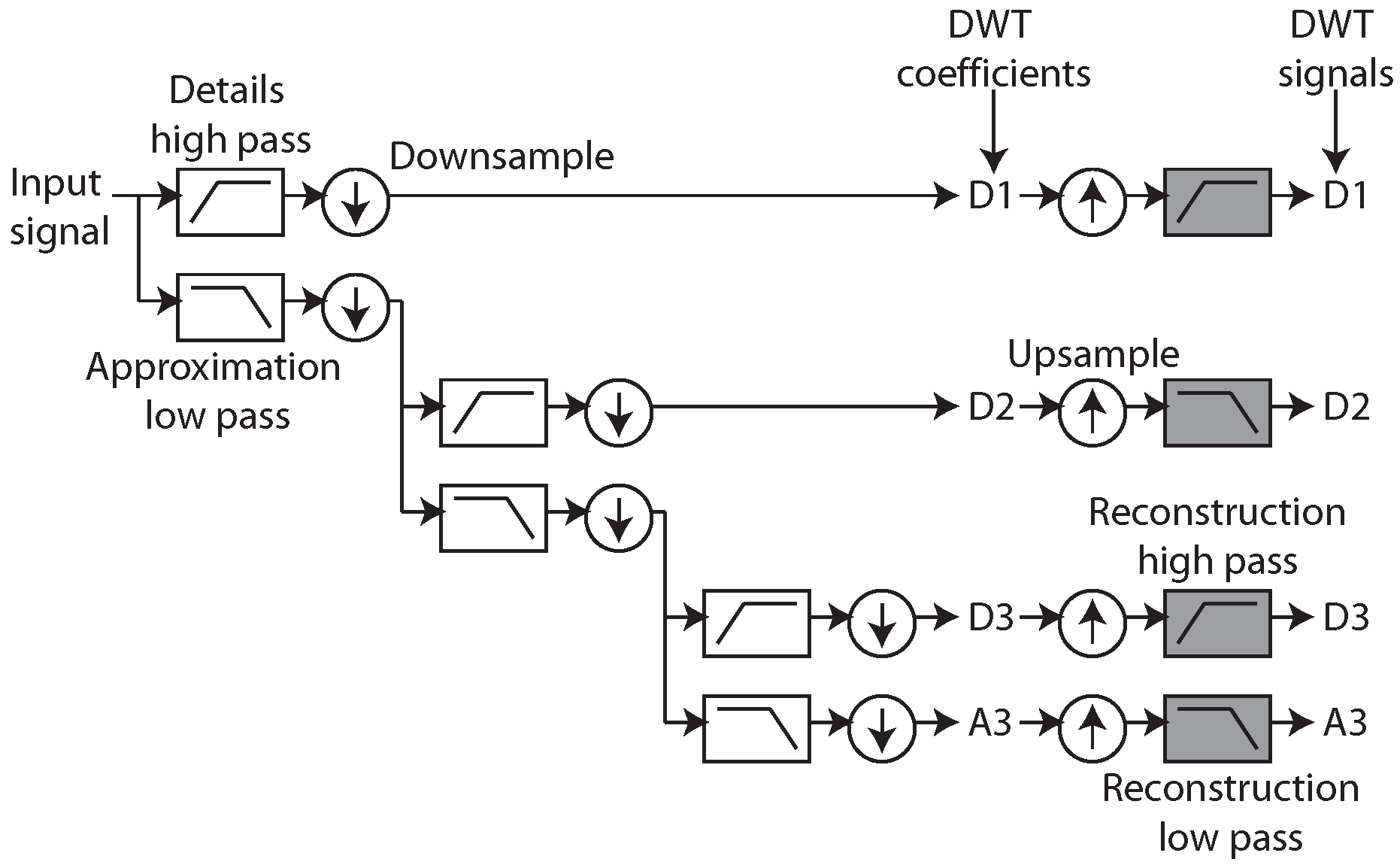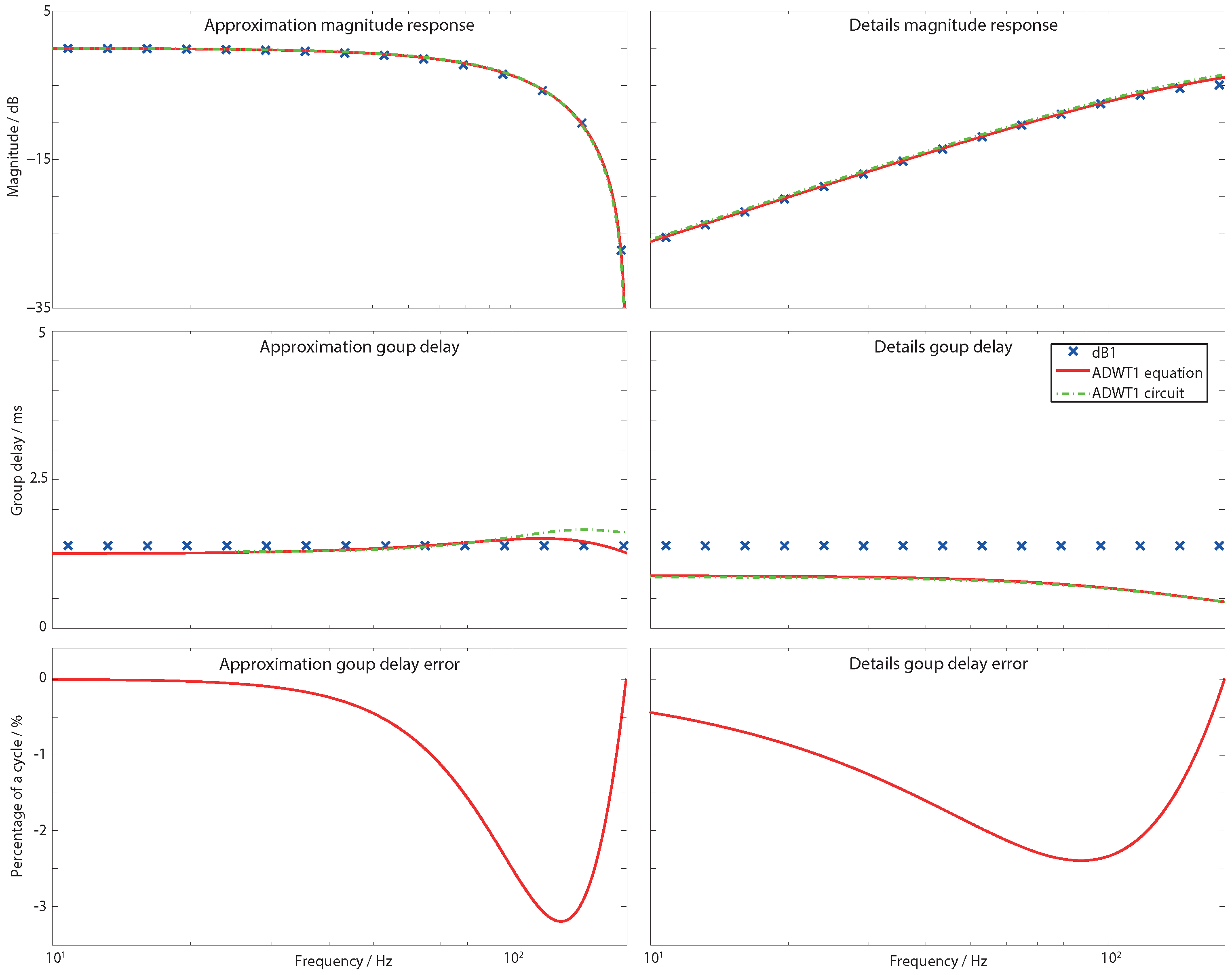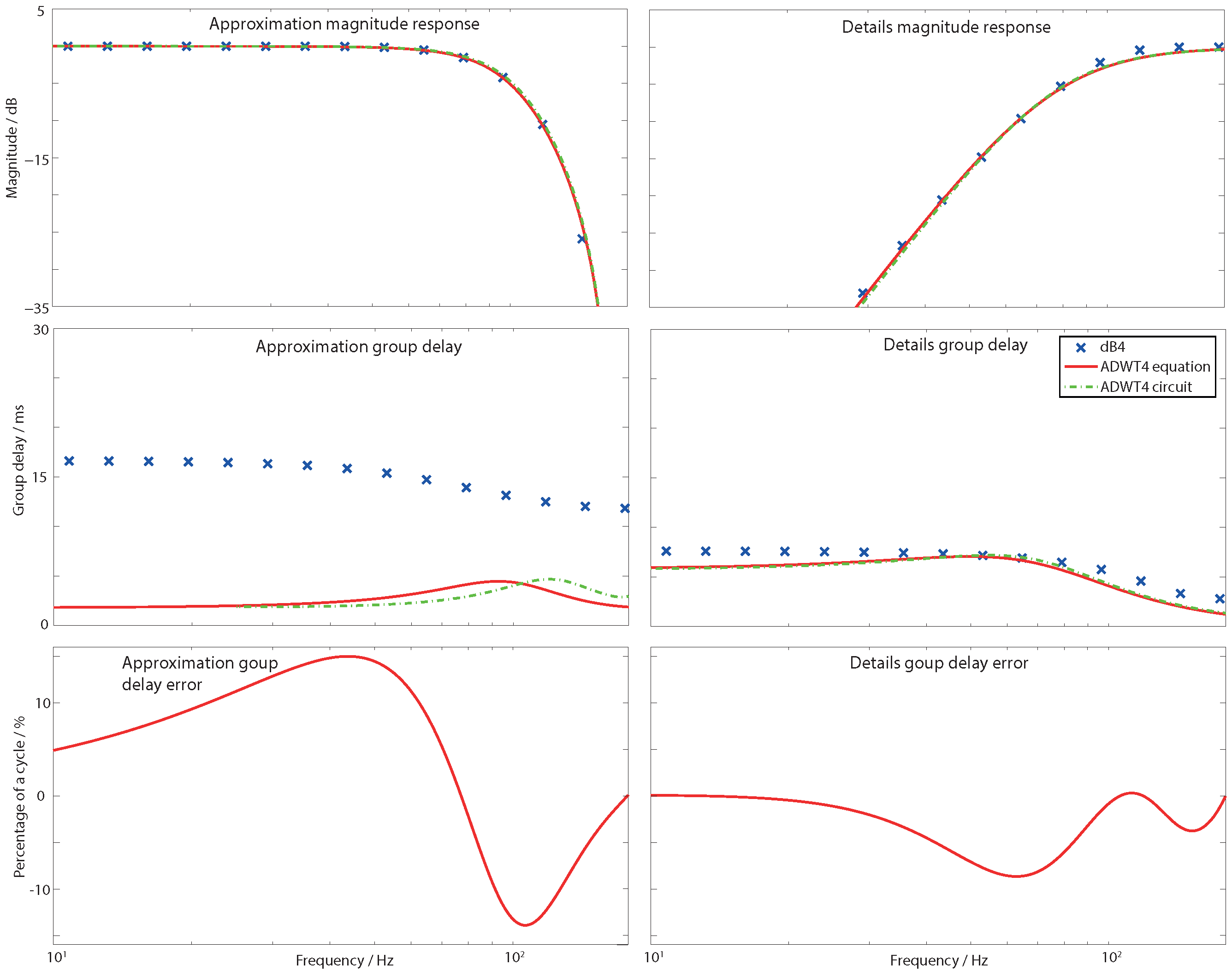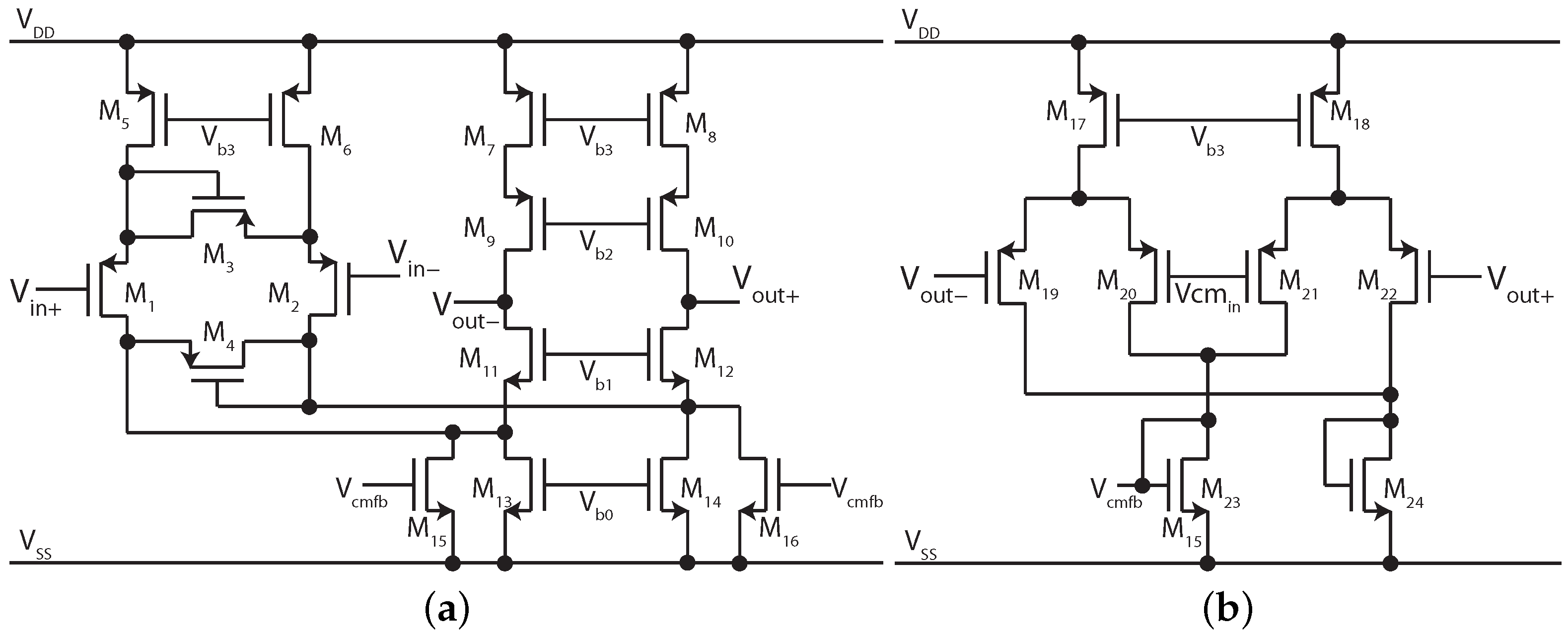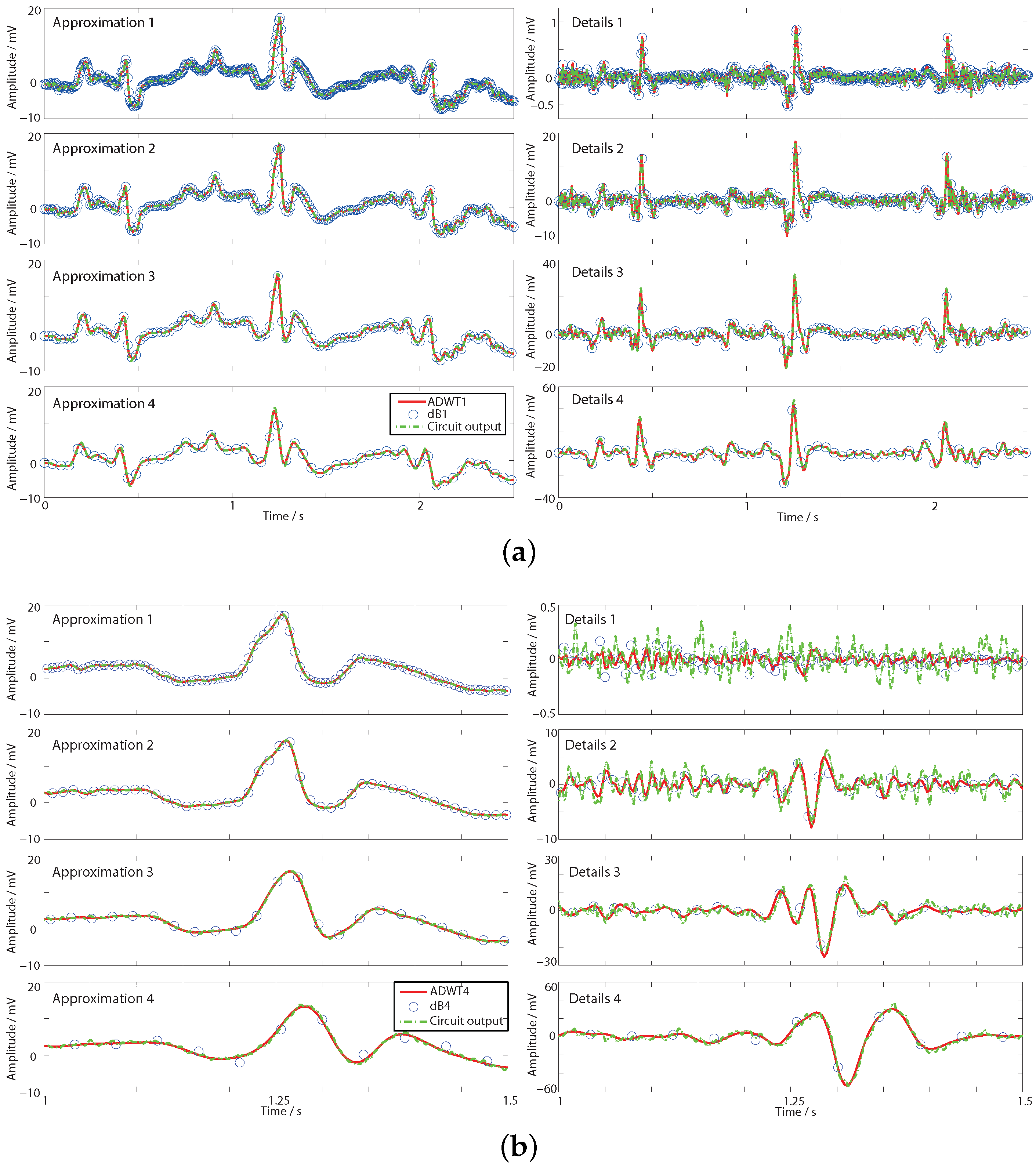1. Introduction
Ultra low power signal processing is an integral part of all modern sensor nodes, and particularly so in emerging wearable electronics for medical applications which need to be easy-to-use, robust and reliably always work [
1]. In 2010 authors in the IEEE Signal Processing magazine posed the question: “
What does ultra low power consumption mean?”; and came to the conclusion that it is where the “
power source lasts longer than the useful life of the product” [
2]. This is exactly what is required for creating truly ubiquitous and wearable sensors. However, to realise such low power signal processing inside the sensor node itself huge advances in power performance are still required.
There is a strong community consensus that the increased use of analog signal processing has an important role in achieving these power advances. For example, [
3] summaries the benefits of analog processing as “
analog computation is more energy- and area-efficient at the cost of its limited accuracy, whereas digital computation is more versatile and derives greater benefits from technology scaling”. This mirrors earlier findings from [
2] that “
the old thought that we would be able to virtually eliminate analog and do everything in digital is dying away and we now have the advantage of making tradeoffs between digital and analog implementation for SP [Signal Processing].” Further examples on the role of analog processing can be found in [
2,
3,
4,
5,
6,
7,
8,
9,
10,
11].
Low power embedded signal processing based upon making greater use of the analog domain are thus starting to emerge. [
3,
11] are both recent papers making use of analog signal processing to power efficiently complement digital signal processing: the rejection of interference signals through feedback loop filtering in [
11], and the implementation of core signal processing functions (max, min, multiplication) in [
3]. Driven by this there is now a strong emphasis on decreasing the power consumption of existing analog signal processing stages, and in creating new, novel, analog signal processing circuits which can allow greater flexibility in algorithm design, and give more choices for the signal processing approach when working in the analog domain, when creating on-sensor node signal processing.
The Continuous Wavelet Transform (CWT) is a signal processing basis used for providing time–frequency decompositions [
12,
13] that is an excellent example of signal processing which can be implemented very power efficiently in the analog domain. Several different CWT implementations have been reported in recent years for implementing continuous wavelets without scaling functions (such as the Morlet, Mexican Hat, Gaussian derivatives) using nano-Watts to pico-Watts of power [
5,
14,
15,
16,
17,
18,
19,
20]. The recent developments in this area started with [
14] which introduced a mathematical approximation method, based upon Padé expansions, for mapping a non-causal, ideal, mother wavelet function into the form of a continuous time transfer function that is suitable for circuit realisation. The mathematical approximation method was improved upon in [
15] which presented a Gaussian wavelet filter with mathematically optimal dynamic range. Low power operation (down to 45 nW in the case of [
15]) is achieved through the use of
C circuit topologies where the power consumption is directly proportional to the centre-frequency of the time–frequency decomposition. [
17] and [
18] both take a similar approach, using analog domain
C topologies to minimize power. As a result these low power CWT implementations have shown particular utility for the processing of low voltage/low frequency biomedical signals such as from electro-physiology—the ECG (electrocardiogram) from the heart and EEG (electroencephalogram) from the brain. Electro-physiological processing is the focus of [
5], [
19] and [
20]. Based upon this, previous work by the authors of the current paper, [
19], demonstrates that CWT analysis of EEG signals can be performed using down to 60 pW of power.
The Discrete Wavelet Transform (DWT) is closely related to the CWT,
Figure 1, and provides alternative time–frequency decompositions. It has proved to be a highly useful signal processing basis and is widely used in applications ranging from data compression, to de-noising, to feature extraction [
12,
13,
21,
22]. For example, DWT coefficients have been shown to be one of the single best features for discriminating between seizure and non-seizure sections in the epileptic EEG [
23], and is now widely used for the detection of abnormalities in the EEG [
24,
25]. As a result many VLSI implementations of the 1D DWT have been reported previously [
17,
26,
27,
28,
29,
30,
31,
32,
33,
34]. However, until now, only digital domain approaches to the DWT have been considered. The DWT has therefore: not been available as a signal processing choice for novel analog signal processing in sensor nodes; it has not been possible to perform wavelet tree decompositions in analog; and the choice of mother wavelets available for use in analog has been restricted to Morlet, Mexican Hat, and Gaussian derivative CWT wavelets.
This paper presents a new on-chip analog domain approach to approximating the DWT. It is well accepted that the CWT is not restricted to the continuous time domain and that CWT-like information can be generated by discrete time systems; for example using the Matlab cwt function. This paper demonstrates that the converse is true for the DWT: it is not restricted to the discrete time domain, and useful DWT-like information can be generated by analog processing circuits. We therefore provide a new signal processing basis for use in emerging analog signal processing systems, giving designers increased flexibility and algorithm choices when working at very low power levels in wearable sensors. Full circuits for implementing the Analog Discrete Wavelet Transform (ADWT) are presented allowing DWT-like information to be used in on-sensor node analog signal processing systems for the first time.
Section 2 introduces the new ADWT and the time–frequency decomposition provided. This corresponds to a filtering operation with the discrete
z domain DWT filters mapped to the analog
s domain, suitable for implementation as continuous time analog filters. These responses are generated for Butterworth and Daubechies maximally flat mother wavelet responses, with the ADWT operation illustrated by decomposing human ECG signals.
Section 3 then demonstrates the practical use of the DWT-like information generated by the new ADWT approach by comparing the ADWT and DWT performances when used with an EEG based Artifical Neural Network for determining whether a subject is awake or asleep. Finally,
C circuits realising the ADWT analog filters in a 0.18 μm CMOS process are presented in
Section 4. The circuits are designed for the processing of electro-physiological signals in sensor nodes and demonstrate analog domain DWT processing using nano-Watts of power.
Figure 1.
The Continuous Wavelet Transform (
top), illustrated using the Mexican hat mother wavelet, is a signal processing basis which can be implemented very power efficiently in the analog domain by using fixed
Q bandpass filters [
5,
14,
15,
16,
17,
18,
19]; The Discrete Wavelet Transform (
bottom), illustrated using the Daubechies 4 mother wavelet, is a related time–frequency decomposition transform which uses separate low pass (approximation) and high pass (details) filters; (
Left) Mother wavelet time domain impulse response; (
Right) Corresponding frequency response function.
Figure 1.
The Continuous Wavelet Transform (
top), illustrated using the Mexican hat mother wavelet, is a signal processing basis which can be implemented very power efficiently in the analog domain by using fixed
Q bandpass filters [
5,
14,
15,
16,
17,
18,
19]; The Discrete Wavelet Transform (
bottom), illustrated using the Daubechies 4 mother wavelet, is a related time–frequency decomposition transform which uses separate low pass (approximation) and high pass (details) filters; (
Left) Mother wavelet time domain impulse response; (
Right) Corresponding frequency response function.
3. Application Performance
The utility of the ADWT is demonstrated here by using it in an Artificial Neural Network (ANN) that processes human scalp EEG signals. Two channels of EEG information are used for the two class classification problem of determining whether a subject is asleep or awake. Four, full-day ambulatory recordings of EEG channels FPz–Cz and Pz–Oz sampled at 100 Hz are used [
38,
40].
The ANN is a five layer feed-forward network [
41] (patternnet) which classifies the subject state based upon the DWT generated spectral powers. A four level DWT decomposition is used generating power information in the ranges:
Details, level 2: 12.5–25 Hz.
Details, level 3: 6.25–12.5 Hz.
Details, level 4: 3.125–6.25 Hz.
Approximations, level 4: 0–3.125 Hz.
This gives a total of eight features for the network to use for classification. The level 1 details coefficients have been excluded from the analysis in-line with the results from
Figure 6b (
Section 2.3) which showed that the level 1 details output is a relatively poor estimation due to high frequency noise being present directly at the input of the level 1 filter. Physiologically, this corresponds to excluding components from the EEG
gamma band, those above 25 Hz, from the analysis. This is not an uncommon choice for EEG analysis: while gamma band information has shown utility for sleep analysis [
42], the physiological
vs. artifactual origin of the higher frequency components has been debated [
43].
The band powers are generated in 30 s non-overlapping epochs and a classification decision made for each of the 11,318 epochs present over the four EEG recordings. A scaled conjugate gradient backpropagation training routine is used, combined with a leave-one-out cross-validation procedure where the network is trained on three of the records and tested on the fourth. All four permutations are analysed and the reported performance taken as the average of the four out-of-sample tests.
To illustrate the classification performance the two metrics of interest are the (TP: True Positives; FN: False Negatives; FP: False Positives. See [
44].):
which gives the fraction of expert marked wake(sleep) epochs that are correctly classified as wake(sleep), and the
which shows the fraction of classifications of a given class which are correct. In both cases higher numbers represent better performance and in general there is a trade-off between correctly classifying epochs (having a high sensitivity), and having few false detections (high selectivity).
Results are shown in
Table 3 for two different networks. One uses power estimates generated with the dB1 mother wavelet as input features while the other uses dB4 based features. It can be seen how good classification performance is obtained in all cases. The dB1 network achieves higher sensitivities for correctly identifying sleep in the EEG, while the dB4 network achieves higher sensitivities for the detection of wake. There is a similar trade-off in the selectivity with the dB1 network achieving fewer false positives in the wake class and the dB4 network achieving fewer false positives in the sleep class.
Table 3.
Performance of an Artificial Neural Network for determining wake/sleep state from the EEG using DWT spectral powers.
Table 3.
Performance of an Artificial Neural Network for determining wake/sleep state from the EEG using DWT spectral powers.
| Training Features; | Wake | Sleep |
|---|
| Test Features | Sensitivity / % | Selectivity / % | Sensitivity / % | Selectivity / % |
|---|
| | dB1 |
| DWT; DWT | 95.8 | 98.5 | 97.2 | 92.4 |
| DWT; ADWT | 95.2 | 98.7 | 97.6 | 91.5 |
| | dB4 |
| DWT ; DWT | 98.1 | 94.7 | 89.0 | 96.0 |
| DWT ; ADWT | 98.0 | 94.2 | 87.7 | 96.0 |
To assess the ADWT, results are also presented in
Table 3 for the case when the networks are tested using ADWT generated band powers as the input features. The same artificial neural networks as before are used, trained on the same DWT band powers, only the inputs during the out-of-sample tests have been changed to use the ADWT. In all cases for these networks the classification performances are very similar, and the maximum performance difference is only 1.3%.
Inevitably, the ADWT is an estimation of the underlying DWT and so small differences are present in the ANN output due to the differences in group delay. These are to be expected and their impact will vary between different applications. Nevertheless, the analysis of ECG data in
Figure 6 and of 94 h of EEG data in
Table 3 has demonstrated the potential use of the ADWT in generating useful DWT-like information. In particular, during deployment of the EEG artificial neural network used here the ADWT based powers could be used in place of the DWT and the classification performance essentially unchanged.
